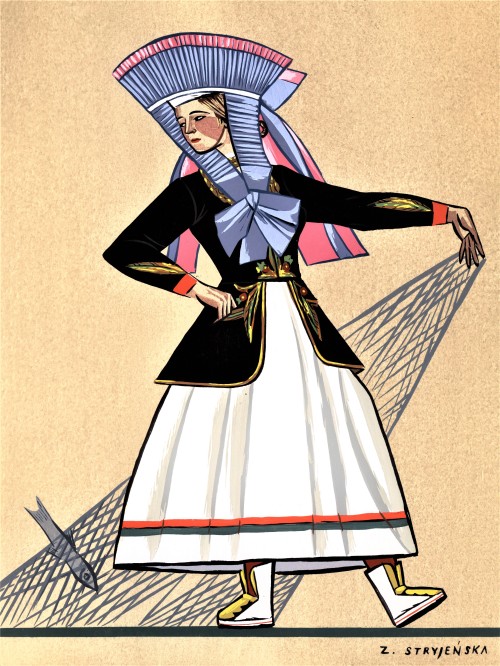uwmspeccoll:Another Folk Fashion Friday! This week we have another great set of plates featuring fol
uwmspeccoll:Another Folk Fashion Friday! This week we have another great set of plates featuring folk costume, this time from Poland. Polish Peasant Costumes, published in 1939 by C. Szwedzicki in Nice, France, in an edition of 400 copies signed by the publisher, features 40 pochoir plates of paintings by Polish artist Zofia Stryjeńska. One of the most influential Polish women artists of the interwar period, Stryjeńska learned her craft at the Academy of Fine Arts in Munich, where she enrolled as a man to circumvent the proscription on women students. Stryjeńska’s works mostly utilized the tempura technique, often combining Polish folk iconography with Christian religious motif. Very little is known about the publisher, C. Szwedzicki, including their first name. What is known is that they operated a fine arts press out of Nice, France. Szwedzicki became known to an international audience in 1929, when they published the portfolio, Kiowa Indian Art, commissioned by Swedish-American painter and curator Oscar Jacobson. Szwedzicki produced 6 volumes of Native American Art with Jacobson, but work on these volumes was interrupted when his business was seized, either by German Nazis or French Pétainists, and Szwedzicki was shipped off to Poland. Szwedzicki survived and Jacobson, with some difficulty, located him in Nice after the war as Szwedzicki worked to rebuild his business. Polish Peasant Costumes and the 6 portfolios of Native American art produced for Jacobson are the only extant works known to be produced by this publisher, but the skill of the printing indicates a larger body a work that has likely been lost to the ravages of WWII and the march of time. Printed in 1939, Polish Peasant Costumes would have been published prior to Szwedzicki’s internment in Poland. Included is an introduction and descriptions of the plates in English and French by Polish artist, museologist, and researcher of folk art Seweryn Tadeusz. He writes, “The costume is a child of the soil, for it is the outgrowth of the crops that are raised, of the beasts that are bred and of the means whereby raw materials are worked. Hence, it forms a part of the landscape.” Included here, in order, are: Keep reading -- source link
Tumblr Blog : uwmspeccoll.tumblr.com









